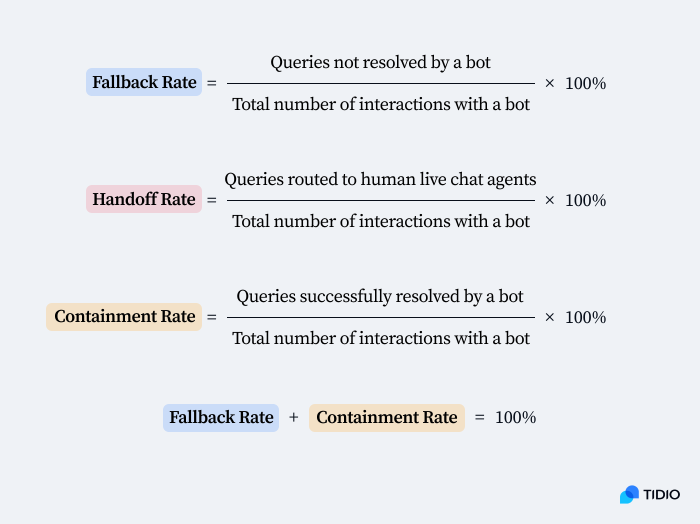Chatbot Fallback Rate
A Chatbot Fallback Rate is a Chatbot Performance Metric that quantifies the percentage of interactions in which a chatbot fails to understand or appropriately respond to the user's input.
- Context:
- It is a critical metric for evaluating a chatbot's ability to handle interactions autonomously without escalating to human agents.
- It can reflect the effectiveness of the chatbot's Natural Language Processing capabilities and training.
- It can (often) employs strategies to reduce the fallback rate include expanding the chatbot's training data, implementing more sophisticated NLP techniques, and refining conversational flows to manage user expectations more effectively.
- It can be estimated as: [math]\displaystyle{ \text{Fallback Rate}=\dfrac{\text{Queries not resolved by a bot}}{\text{Total number of interactions witha bot}}\times 100\% }[/math].
- ...
- Example(s):
- Chatbots with a low fallback rate are typically well-trained and able to handle a wide range of user inquiries effectively, demonstrating high conversational AI effectiveness.
- Chatbots experiencing a high fallback rate might struggle in complex or ambiguous conversational contexts, requiring more frequent intervention by human support staff.
- ...
- Counter-Example(s):
- Chatbot Handoff Rate,
- Chatbot Containment Rate: A related metric that measures the percentage of interactions a chatbot successfully resolves without human intervention, effectively the inverse of the fallback.
- User Satisfaction Score (CSAT): This measures the overall satisfaction of users with their chatbot interaction experience, focusing on outcomes and user perceptions rather than the chatbot's ability to autonomously handle inquiries.
- User Retention Rate,
- Click-Through Rate (CTR).
- See: Chatbot Analytics, Human Takeover Rate, Natural Language Processing, User Engagement Rate, Chatbot Engagement Measure, Financial Contract Fallback Rate.
References
2024a
- (ChatGPT-OpenAI, 2024) ⇒ Prompt: Summarize the concept Chatbot Fallback Rate in 1- 2 paragraphs. ChatGPT (model:gpt-4-turbo-preview). Retrieved: 2024-03-17.
- QUOTE: The concept of "Chatbot Fallback Rate" relates to a metric used in evaluating the performance of chatbots, particularly in handling inquiries or tasks posed by users. It quantifies the percentage of times a chatbot must revert to a default response or escalate the query to a human operator because it cannot understand or process the user's request accurately. Essentially, it is a measure of a chatbot's inability to independently resolve an interaction.
A high fallback rate signifies that the chatbot frequently encounters difficulties in comprehending user requests or lacks the knowledge base or decision-making capability to offer appropriate responses. This metric is crucial for developers and businesses as it highlights areas where the chatbot's performance can be improved, either through enhancing its AI and machine learning algorithms, expanding its knowledge base, or refining its NLP (Natural Language Processing) capabilities. Lowering the fallback rate is key to improving user satisfaction and operational efficiency, making it an important aspect of chatbot optimization and development.
- QUOTE: The concept of "Chatbot Fallback Rate" relates to a metric used in evaluating the performance of chatbots, particularly in handling inquiries or tasks posed by users. It quantifies the percentage of times a chatbot must revert to a default response or escalate the query to a human operator because it cannot understand or process the user's request accurately. Essentially, it is a measure of a chatbot's inability to independently resolve an interaction.
2024b
- (Rajnerowicz, 2024) ⇒ Kazimierz Rajnerowicz (2024). "Chatbot Analytics: 9 Key Metrics You Must Track in 2024". In: tidio.com.
- QUOTE: When a chatbot cannot answer a question, we call it a chatbot fallback. Tidio creates automatic reports about your chatbot fallback rate (FBR) for specific types of questions. You can set up conversational AI chatbots that use natural language processing (NLP) and handle these categories of questions automatically. It will significantly reduce both your chatbot fallback rate and the subsequent chat handoffs.

- QUOTE: When a chatbot cannot answer a question, we call it a chatbot fallback. Tidio creates automatic reports about your chatbot fallback rate (FBR) for specific types of questions. You can set up conversational AI chatbots that use natural language processing (NLP) and handle these categories of questions automatically. It will significantly reduce both your chatbot fallback rate and the subsequent chat handoffs.